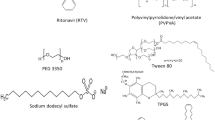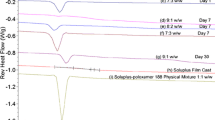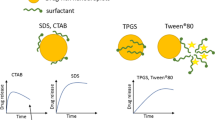Abstract
Purpose
To understand how surfactants affect drug release from ternary amorphous solid dispersions (ASDs), and to investigate different mechanisms of release enhancement.
Methods
Ternary ASDs containing ritonavir (RTV), polyvinylpyrrolidone/vinyl acetate (PVPVA) and a surfactant (sodium dodecyl sulfate (SDS), Tween 80, Span 20 or Span 85) were prepared with rotary evaporation. Release profiles of ternary ASDs were measured with surface normalized dissolution. Phase separation morphologies of ASD compacts during hydration/dissolution were examined in real-time with a newly developed confocal fluorescence microscopy method. The water ingress rate of different formulations was measured with dynamic vapor sorption. Microscopy was employed to check for matrix crystallization during release studies.
Results
All surfactants improved drug release at 30% DL, while only SDS and Tween 80 improved drug release at higher DLs, although SDS promoted matrix crystallization. The dissolution rate of neat polymer increased when SDS and Tween 80 were present. The water ingress rate also increased in the presence of all surfactants. Surfactant-incorporation affected both the kinetic and thermodynamics factors governing phase separation of RTV-PVPVA-water system, modifying the phase morphology during ASD dissolution. Importantly, SDS increased the miscibility of RTV-PVPVA-water system, whereas other surfactants mainly affected the phase separation kinetics/drug-rich barrier persistence.
Conclusion
Incorporation of surfactants enhanced drug release from RTV-PVPVA ASDs compared to the binary system. Increased drug-polymer-water miscibility and disruption of the drug-rich barrier at the gel-solvent interface via plasticization are highlighted as two key mechanisms underlying surfactant impacts based on direct visualization of the phase separation process upon hydration and release.






















Similar content being viewed by others
Data Availability
The authors confirm that the data supporting the findings of this study are available within the article and its supplementary materials.
Abbreviations
- AAPS:
-
Amorphous-amorphous phase separation
- ASD:
-
Amorphous solid dispersions
- ATR-FTIR:
-
Attenuated total reflectance—Fourier transform infrared
- DCM:
-
Dichloromethane
- DL:
-
Drug loading
- DSC:
-
Differential scanning calorimetry
- DVS:
-
Dynamic vapor sorption
- HLB:
-
Hydrophilic-lipophilic balance
- HPLC:
-
High-performance liquid chromatography
- HPMCAS:
-
Hydroxypropyl methylcellulose acetate succinate
- HPMCP:
-
Hydroxypropyl methylcellulose phthalate
- HTS:
-
High throughput screening
- IDR:
-
Intrinsic dissolution apparatus
- LoC:
-
Limit of congruency
- PE:
-
Pass energies
- PLM:
-
Polarized light microscopy
- PVPVA:
-
Polyvinylpyrrolidone/vinyl acetate
- RTV:
-
Ritonavir
- RH:
-
Relative humidity
- SEM:
-
Scanning electron microscope
- SDS:
-
Sodium dodecyl sulfate
- SL:
-
Surfactant level
- Span 20:
-
Sorbitan monolaurate
- Span 85:
-
Sorbitan trioleate
- T g :
-
Glass transition temperature
- THF:
-
Tetrahydrofuran
- TPGS:
-
Tocopherol polyethylene glycol succinate
- Tween 80:
-
Polyoxyethylene sorbitan monooleate
- UV:
-
Ultraviolet
- XPS:
-
X-ray photoelectron spectroscopy
References
Wildey MJ, Haunso A, Tudor M, Webb M, Connick JH. High-throughput screening. In: Platform Technologies in Drug Discovery and Validation. 2017;50:149–95.
Williams HD, Trevaskis NL, Charman SA, Shanker RM, Charman WN, Pouton CW, Porter CJH. Strategies to address low drug solubility in discovery and development. Pharmacol Rev. 2013;65(1):315–499.
Huang Y, Dai WG. Fundamental aspects of solid dispersion technology for poorly soluble drugs. Acta Pharmaceutica Sinica B. 2014;4(1):18–25.
Indulkar AS, Lou X, Zhang GGZ, Taylor LS. Insights into the dissolution mechanism of ritonavir-copovidone amorphous solid dispersions: Importance of congruent release for enhanced performance. Mol Pharm. 2019;16(3):1327–39.
Chen Y, Wang S, Wang S, Liu C, Su C, Hageman M, Hussain M, Haskell R, Stefanski K, Qian F. Initial Drug Dissolution from Amorphous Solid Dispersions Controlled by Polymer Dissolution and Drug-Polymer Interaction. Pharm Res. 2016;33(10):2445–58.
Tho I, Liepold B, Rosenberg J, Maegerlein M, Brandl M, Fricker G. Formation of nano/micro-dispersions with improved dissolution properties upon dispersion of ritonavir melt extrudate in aqueous media. Eur J Pharm Sci. 2010;40(1):25–32.
McGovern SL, Helfand BT, Feng B, Shoichet BK. A specific mechanism of nonspecific inhibition. J Med Chem. 2003;46(20):4265–72.
Indulkar AS, Gao Y, Raina SA, Zhang GG, Taylor LS. Exploiting the phenomenon of liquid-liquid phase separation for enhanced and sustained membrane transport of a poorly water-soluble drug. Mol Pharm. 2016;13(6):2059–69.
Stewart AM, Grass ME, Brodeur TJ, Goodwin AK, Morgen MM, Friesen DT, Vodak DT. Impact of drug-rich colloids of itraconazole and hpmcas on membrane flux in vitro and oral bioavailability in rats. Mol Pharm. 2017;14(7):2437–49.
Kesisoglou F, Wang M, Galipeau K, Harmon P, Okoh G, Xu W. Effect of amorphous nanoparticle size on bioavailability of anacetrapib in dogs. J Pharm Sci. 2019;108(9):2917–25.
Frenkel YV, Clark AD Jr, Das K, Wang YH, Lewi PJ, Janssen PA, Arnold E. Concentration and pH dependent aggregation of hydrophobic drug molecules and relevance to oral bioavailability. J Med Chem. 2005;48(6):1974–83.
Yang R, Mann AKP, Van Duong T, Ormes JD, Okoh GA, Hermans A, Taylor LS. Drug Release and Nanodroplet Formation from Amorphous Solid Dispersions: Insight into the Roles of Drug Physicochemical Properties and Polymer Selection. Mol Pharm. 2021;18(5):2066–81.
Hiew TN, Zemlyanov DY, Taylor LS. Balancing Solid-State Stability and Dissolution Performance of Lumefantrine Amorphous Solid Dispersions: The Role of Polymer Choice and Drug-Polymer Interactions. Mol Pharm. 2022;19(2):392–413.
Purohit HS, Taylor LS. Phase behavior of ritonavir amorphous solid dispersions during hydration and dissolution. Pharm Res. 2017;34(12):2842–61.
Li N, Taylor LS. Microstructure formation for improved dissolution performance of lopinavir amorphous solid dispersions. Mol Pharm. 2019;16(4):1751–65.
Han YR, Ma Y, Lee PI. Impact of phase separation morphology on release mechanism of amorphous solid dispersions. Eur J Pharm Sci. 2019;136: 104955.
Yang R, Zhang GGZ, Zemlyanov DY, Purohit HS, Taylor LS. Release mechanisms of amorphous solid dispersions: role of drug-polymer phase separation and morphology. J Pharm Sci. 2023;112(1):304–17.
Farrell B, French Merkley V, Ingar N. Reducing pill burden and helping with medication awareness to improve adherence. Can Pharm J (Ott). 2013;146(5):262–9.
An J, Lee JS, Sharpsten L, Wilson AK, Cao F, Tran JN. Impact of pill burden on adherence to hepatitis C medication. Curr Med Res Opin. 2019;35(11):1937–44.
Meng F, Ferreira R, Zhang F. Effect of surfactant level on properties of celecoxib amorphous solid dispersions. J Drug Deliv Sci Technol. 2019;49:301–7.
Feng D, Peng T, Huang Z, Singh V, Shi Y, Wen T, Lu M, Quan G, Pan X, Wu C. Polymer(-)Surfactant System Based Amorphous Solid Dispersion: Precipitation Inhibition and Bioavailability Enhancement of Itraconazole. Pharma. 2018;10(2):53.
Tung NT, Tran CS, Nguyen TL, Pham TM, Chi SC, Nguyen HA, Bui QD, Bui DN, Tran TQ. Effect of surfactant on the in vitro dissolution and the oral bioavailability of a weakly basic drug from an amorphous solid dispersion. Eur J Pharm Sci. 2021;162.
Correa-Soto CE, Gao Y, Indulkar AS, Zhang GGZ, Taylor LS. Role of Surfactants in Improving Release from Higher Drug Loading Amorphous Solid Dispersions. Int J Pharm. 2022:122120.
Correa Soto CE, Gao Y, Indulkar AS, Ueda K, Zhang GGZ, Taylor LS. Impact of Surfactants on the Performance of Clopidogrel-Copovidone Amorphous Solid Dispersions: Increased Drug Loading and Stabilization of Nanodroplets. Pharm Res. 2022;39(1):167–88.
Schittny A, Philipp-Bauer S, Detampel P, Huwyler J, Puchkov M. Mechanistic insights into effect of surfactants on oral bioavailability of amorphous solid dispersions. J Control Release. 2020;320:214–25.
Jermain SV, Brough C, Williams RO 3rd. Amorphous solid dispersions and nanocrystal technologies for poorly water-soluble drug delivery - An update. Int J Pharm. 2018;535(1–2):379–92.
Saboo S, Bapat P, Moseson DE, Kestur US, Taylor LS. Exploring the role of surfactants in enhancing drug release from amorphous solid dispersions at higher drug loadings. Pharm. 2021;13(5):735.
Que C, Lou X, Zemlyanov DY, Mo H, Indulkar AS, Gao Y, Zhang GGZ, Taylor LS. Insights into the dissolution behavior of ledipasvir-copovidone amorphous solid dispersions: Role of drug loading and intermolecular interactions. Mol Pharm. 2019;16(12):5054–67.
Harmon P, Galipeau K, Xu W, Brown C, Wuelfing WP. Mechanism of dissolution-induced nanoparticle formation from a copovidone-based amorphous solid dispersion. Mol Pharm. 2016;13(5):1467–81.
Solanki NG, Lam K, Tahsin M, Gumaste SG, Shah AV, Serajuddin ATM. Effects of surfactants on Itraconazole-HPMCAS solid dispersion prepared by hot-melt extrusion I: Miscibility and drug release. J Pharm Sci. 2019;108(4):1453–65.
Dave RH, Patel AD, Donahue E, Patel HH. To evaluate the effect of addition of an anionic surfactant on solid dispersion using model drug indomethacin. Drug Dev Ind Pharm. 2012;38(8):930–9.
Dave RH, Patel HH, Donahue E, Patel AD. To evaluate the change in release from solid dispersion using sodium lauryl sulfate and model drug sulfathiazole. Drug Dev Ind Pharm. 2013;39(10):1562–72.
Vinarov Z, Katev V, Radeva D, Tcholakova S, Denkov ND. Micellar solubilization of poorly water-soluble drugs: effect of surfactant and solubilizate molecular structure. Drug Dev Ind Pharm. 2018;44(4):677–86.
Balakrishnan A, Rege BD, Amidon GL, Polli JE. Surfactant-mediated dissolution: contributions of solubility enhancement and relatively low micelle diffusivity. J Pharm Sci. 2004;93(8):2064–75.
Jay P, Lakshman YC, Kowalski James, Serajuddin Abu T. M. Application of Melt Extrusion in the Development of a Physically and Chemically Stable High-Energy Amorphous Solid Dispersion of a Poorly Water-Soluble Drug. Mol Pharm. 2008;5(6):994–1002.
Luner PE, Babu SR, Mehta SC. Wettability of a hydrophobic drug by surfactant solutions. Int J Pharm. 1996;128(1–2):29–44.
Rahman M, Ahmad S, Tarabokija J, Bilgili E. Roles of surfactant and polymer in drug release from spray-dried hybrid nanocrystal-amorphous solid dispersions (HyNASDs). Powder Technol. 2020;361:663–78.
Chaudhari SP, Dugar RP. Application of surfactants in solid dispersion technology for improving solubility of poorly water soluble drugs. J Drug Deliv Sci Technol. 2017;41:68–77.
Yang R, Zhang GGZ, Kjoller K, Dillon E, Purohit HS, Taylor LS. Phase separation in surfactant-containing amorphous solid dispersions: Orthogonal analytical methods to probe the effects of surfactants on morphology and phase composition. Int J Pharm. 2022;619: 121708.
Kapourani A, Tzakri T, Valkanioti V, Kontogiannopoulos KN, Barmpalexis P. Drug crystal growth in ternary amorphous solid dispersions: Effect of surfactants and polymeric matrix-carriers. Int J Pharm X. 2021;3: 100086.
Baghel S, Cathcart H, O’Reilly NJ. Investigation into the Solid-State Properties and Dissolution Profile of Spray-Dried Ternary Amorphous Solid Dispersions: A Rational Step toward the Design and Development of a Multicomponent Amorphous System. Mol Pharm. 2018;15(9):3796–812.
Li S, Dong B, Wang J, Li J, Shen T, Peng H, Ling X. Synthesis and characterization of mixed alkanes microcapsules with phase change temperature below ice point for cryogenic thermal energy storage. Energy. 2019;187:115898
Dinarvand R, Moghadam SH, Sheikhi A, Atyabi F. Effect of surfactant HLB and different formulation variables on the properties of poly-D, L-lactide microspheres of naltrexone prepared by double emulsion technique. J Microencapsul. 2005;22(2):139–51.
Yoshioka T, Sternberg B, Florence A. Preparation and properties of vesicles (niosomes) of sorbitan monoesters (Span 20, 40, 60 and 80) and a sorbitan triester (Span 85). Int J Pharm. 1994;105(1):1–6.
Fowler SD, Greenspan P. Application of Nile red, a fluorescent hydrophobic probe, for the detection of neutral lipid deposits in tissue sections: comparison with oil red O. J Histochem Cytochem. 1985;33(8):833–6.
Horst R, Wolf BA. Phase diagrams calculated for quaternary polymer blends. J Chem Phys. 1995;103(9):3782–7.
Griffiths RB. Thermodynamic model for tricritical points in ternary and quaternary fluid mixtures. J Chem Phys. 1974;60(1):195–206.
Bellocq A-M, Biais J, Clin B, Gelot A, Lalanne P, Lemanceau B. Three—dimensional phase diagram of the brine-toluene-butanol-sodium dodecyl sulfate system. J Colloid Interface Sci. 1980;74(2):311–21.
Papanu JS, Soane DS, Bell AT, Hess DW. Transport models for swelling and dissolution of thin polymer films. J Appl Polym Sci. 1989;38(5):859–85.
Colombo P, Bettini R, Santi P, Peppas NA. Swellable matrices for controlled drug delivery: gel-layer behaviour, mechanisms and optimal performance. Pharm Sci Technol Today. 2000;3(6):198–204.
Yu J, Li Y, Yao X, Que C, Huang L, Hui HW, Gong Y, Qian F, Yu L. Surface Enrichment of Surfactants in Amorphous Drugs: An X-ray Photoelectron Spectroscopy Study. Mol Pharm. 2022;19(2):654–60.
Turner SF, Clarke SM, Rennie AR, Thirtle PN, Cooke DJ, Li ZX, Thomas RK. Adsorption of Sodium Dodecyl Sulfate to a Polystyrene/Water Interface Studied by Neutron Reflection and Attenuated Total Reflection Infrared Spectroscopy. Langmuir. 1999;15(4):1017–23.
Knock MM, Sanii LS. Effect of hydrophobization of gold QCM-D crystals on surfactant adsorption at the solid-liquid interface. Amphiphiles: molecular assembly and applications. Am Chemical Soc. 1070:175–192.
Dominguez H. Self-aggregation of the SDS surfactant at a solid-liquid interface. J Phys Chem B. 2007;111(16):4054–9.
Oswald S. X-Ray Photoelectron Spectroscopy in Analysis of Surfaces. In. Encycl Anal Chem. 2013.
Tiernan H, Byrne B, Kazarian SG. ATR-FTIR spectroscopy and spectroscopic imaging for the analysis of biopharmaceuticals. Spectrochim Acta A Mol Biomol Spectrosc. 2020;241: 118636.
Luebbert C, Wessner M, Sadowski G. Mutual Impact of Phase Separation/Crystallization and Water Sorption in Amorphous Solid Dispersions. Mol Pharm. 2018;15(2):669–78.
Prudic A, Ji Y, Luebbert C, Sadowski G. Influence of humidity on the phase behavior of API/polymer formulations. Eur J Pharm Biopharm. 2015;94:352–62.
Krummnow A, Danzer A, Voges K, Dohrn S, Kyeremateng SO, Degenhardt M, Sadowski G. Explaining the Release Mechanism of Ritonavir/PVPVA Amorphous Solid Dispersions. Pharm. 2022;14(9):1904.
Deac A, Qi Q, Indulkar AS, Purohit HS, Gao Y, Zhang GGZ, Taylor LS. Dissolution Mechanisms of Amorphous Solid Dispersions: Role of Drug Load and Molecular Interactions. Mol Pharm. 2023;20(1):722–37.
Strathmann H, Kock K. The formation mechanism of phase inversion membranes. Desalination. 1977;21(3):241–55.
Tsai H. Effect of surfactant addition on the morphology and pervaporation performance of asymmetric polysulfone membranes. J Membr Sci. 2000;176(1):97–103.
Wang D-M, Lin F-C, Wu T-T, Lai J-Y. Formation mechanism of the macrovoids induced by surfactant additives. J Membr Sci. 1998;142(2):191–204.
Fung-Ching L, Da-Ming Wang, Cheng-Lee Lai, Juin-Yih Lai. Effect of surfactants on the structure of PMMA membranes. J Membrane Sci. 1997;123(2):281–91.
Saedi S, Madaeni SS, ArabiShamsabadi A, Mottaghi F. The effect of surfactants on the structure and performance of PES membrane for separation of carbon dioxide from methane. Sep Purif Technol. 2012;99:104–19.
Encina GG, Sanghvi SP, Nairn JG. Phase diagram studies of microcapsule formation using hydroxypropyl methylcellulose phthalate. Drug Dev Ind Pharm. 2008;18(5):561–79.
Ariyaprakai S, Dungan SR. Influence of surfactant structure on the contribution of micelles to Ostwald ripening in oil-in-water emulsions. J Colloid Interface Sci. 2010;343(1):102–8.
Weiss J, Canceliere C, McClements DJ. Mass Transport Phenomena in Oil-in-Water Emulsions Containing Surfactant Micelles: Ostwald Ripening. Langmuir. 2000;16(17):6833–8.
Dalvi SV, Dave RN. Controlling Particle Size of a Poorly Water-Soluble Drug Using Ultrasound and Stabilizers in Antisolvent Precipitation. Ind Eng Chem Res. 2009;48(16):7581–93.
Cerdeira AM, Mazzotti M, Gander B. Miconazole nanosuspensions: Influence of formulation variables on particle size reduction and physical stability. Int J Pharm. 2010;396(1–2):210–8.
Saboo S, Kestur US, Flaherty DP, Taylor LS. Congruent release of drug and polymer from amorphous solid dispersions: Insights into the role of drug-polymer hydrogen bonding, surface crystallization, and glass transition. Mol Pharm. 2020;17(4):1261–75.
Ouano AC. Dissolution kinetics of polymers: effect of residual solvent content. Macromolecular Solutions. 1982:208–17.
Cooper WJ, Krasicky PD, Rodriguez F. Effects of molecular weight and plasticization on dissolution rates of thin polymer films. Polymer. 1985;26(7):1069–72.
Cooper WJ, Krasicky PD, Rodriguez F. Dissolution rates of poly(methyl methacrylate) films in mixed solvents. J Appl Polym Sci. 1986;31(1):65–73.
Sarti GC, Gostoli C, Riccioli G, Carbonell RG. Transport of swelling penetrants in glassy polymers: Influence of convection. J Appl Polym Sci. 1986;32(2):3627–47.
Liu C, Chen Z, Chen Y, Lu J, Li Y, Wang S, Wu G, Qian F. Improving Oral Bioavailability of Sorafenib by Optimizing the “Spring” and “Parachute” Based on Molecular Interaction Mechanisms. Mol Pharm. 2016;13(2):599–608.
Bury R, Desmazières B, Treiner C. Interactions between poly(vinylpyrrolidone) and ionic surfactants at various solid/water interfaces: a calorimetric investigation. Colloids Surf, A. 1997;127(1–3):113–24.
Holmberg C, Nilsson S, Sundelöf L-O. Thermodynamic Properties of Surfactant/Polymer/Water Systems with Respect to Clustering Adsorption and Intermolecular Interaction as a Function of Temperature and Polymer Concentration. Langmuir. 1997;13(6):1392–9.
Nilsson S. Interactions between Water-Soluble Cellulose Derivatives and Surfactants. 1. The HPMC/SDS/Water System. Macromol. 2002;28(23):7837–44.
Qi S, Roser S, Edler KJ, Pigliacelli C, Rogerson M, Weuts I, Van Dycke F, Stokbroekx S. Insights into the role of polymer-surfactant complexes in drug solubilisation/stabilisation during drug release from solid dispersions. Pharm Res. 2013;30(1):290–302.
Ghebremeskel AN, Vemavarapu C, Lodaya M. Use of surfactants as plasticizers in preparing solid dispersions of poorly soluble API: stability testing of selected solid dispersions. Pharm Res. 2006;23(8):1928–36.
Indulkar AS, Lou X, Zhang GGZ, Taylor LS. Role of Surfactants on Release Performance of Amorphous Solid Dispersions of Ritonavir and Copovidone. Pharm Res. 2022;39(2):381–94.
Canselier JP. The effects of surfactants on crystallization phenomena. J Dispersion Sci Technol. 2007;14(6):625–44.
Bujan M, Sikirić M, Filipović-Vinceković N, Vdović N, Garti N, Füredi-Milhofer H. Effect of Anionic Surfactants on Crystal Growth of Calcium Hydrogen Phosphate Dihydrate. Langmuir. 2001;17(21):6461–70.
Li Y, Yu J, Tan X, Yu L. Surface Mobility of Amorphous Indomethacin Containing Moisture and a Surfactant: A Concentration-Temperature Superposition Principle. Mol Pharm. 2022;19(8):2962–70.
Dugua J, Simon B. Crystallization of sodium perborate from aqueous solutions. J Cryst Growth. 1978;44(3):280–6.
Funding
Ruochen Yang would like acknowledge ASTAR, Singapore, for funding. The authors would like to thank AbbVie Inc., for the financial support.
Author information
Authors and Affiliations
Corresponding authors
Ethics declarations
Disclosure
AbbVie funded the study and AbbVie and Purdue University jointly participated in study design, research, data collection, analysis and interpretation of data, writing, reviewing, and approving the publication. RY and LST have no additional conflicts of interest to report. HSP, and GGZZ, are employees of AbbVie and may own AbbVie stock.
Additional information
Publisher's Note
Springer Nature remains neutral with regard to jurisdictional claims in published maps and institutional affiliations.
Supplementary Information
Below is the link to the electronic supplementary material.
Rights and permissions
Springer Nature or its licensor (e.g. a society or other partner) holds exclusive rights to this article under a publishing agreement with the author(s) or other rightsholder(s); author self-archiving of the accepted manuscript version of this article is solely governed by the terms of such publishing agreement and applicable law.
About this article
Cite this article
Yang, R., Zhang, G.G.Z., Zemlyanov, D.Y. et al. Drug Release from Surfactant-Containing Amorphous Solid Dispersions: Mechanism and Role of Surfactant in Release Enhancement. Pharm Res 40, 2817–2845 (2023). https://doi.org/10.1007/s11095-023-03502-3
Received:
Accepted:
Published:
Issue Date:
DOI: https://doi.org/10.1007/s11095-023-03502-3




